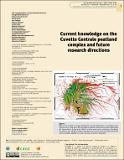Files in this item
Current knowledge on the Cuvette Centrale peatland complex and future research directions
Item metadata
| dc.contributor.author | Biddulph, George Elliot | |
| dc.contributor.author | Bocko, Yannick Enock | |
| dc.contributor.author | Bola, Pierre | |
| dc.contributor.author | Crezee, Bart | |
| dc.contributor.author | Dargie, Greta C. | |
| dc.contributor.author | Emba, Ovide | |
| dc.contributor.author | Georgiou, Selena | |
| dc.contributor.author | Girkin, Nicholas | |
| dc.contributor.author | Hawthorne, Donna | |
| dc.contributor.author | Jovani-Sancho, Jonay | |
| dc.contributor.author | Kanyama T., Joseph | |
| dc.contributor.author | Mampouya, Wenina Emmanuel | |
| dc.contributor.author | Mbemba, Mackline | |
| dc.contributor.author | Sciumbata, Matteo | |
| dc.contributor.author | Tyrell, Genevieve | |
| dc.date.accessioned | 2022-02-18T15:30:16Z | |
| dc.date.available | 2022-02-18T15:30:16Z | |
| dc.date.issued | 2022-01-04 | |
| dc.identifier | 277891273 | |
| dc.identifier | b8527f1c-a321-4875-8852-2d2cb6130338 | |
| dc.identifier | 85124013038 | |
| dc.identifier | 000740804200001 | |
| dc.identifier.citation | Biddulph , G E , Bocko , Y E , Bola , P , Crezee , B , Dargie , G C , Emba , O , Georgiou , S , Girkin , N , Hawthorne , D , Jovani-Sancho , J , Kanyama T. , J , Mampouya , W E , Mbemba , M , Sciumbata , M & Tyrell , G 2022 , ' Current knowledge on the Cuvette Centrale peatland complex and future research directions ' , Bois et Forêts des Tropiques , vol. 350 , pp. 3-14 . https://doi.org/10.19182/bft2021.350.a36288 | en |
| dc.identifier.issn | 1777-5760 | |
| dc.identifier.other | RIS: urn:64D994B89167780A5B871D6FF896F711 | |
| dc.identifier.uri | https://hdl.handle.net/10023/24908 | |
| dc.description | CongoPeat Early Careers Researchers Group is a group of early career researchers who work directly or in partnership with the NERC funded CongoPeat project (NERC reference no.: NE/R016860/1; https://congopeat.net), which has provided the authors with full or partial financial and academic support. | en |
| dc.description.abstract | The Cuvette Centrale is the largest tropical peatland complex in the world, covering approximately 145,000 km2 across the Republic of Congo and the Democratic Republic of Congo. It stores ca. 30.6 Pg C, the equivalent of three years of global carbon dioxide emissions and is now the first trans-national Ramsar site. Despite its size and importance as a global carbon store, relatively little is known about key aspects of its ecology and history, including its formation, the scale of greenhouse gas flows, its biodiversity and its history of human activity. Here, we synthesise available knowledge on the Cuvette Centrale, identifying key areas for further research. Finally, we review the potential of mathematical models to assess future trajectories for the peatlands in terms of the potential impacts of resource extraction or climate change. | |
| dc.format.extent | 12 | |
| dc.format.extent | 943020 | |
| dc.language.iso | eng | |
| dc.relation.ispartof | Bois et Forêts des Tropiques | en |
| dc.subject | Anthropocene | en |
| dc.subject | Democratic Republic of Congo | en |
| dc.subject | Tropical peatland | en |
| dc.subject | Carbon storage | en |
| dc.subject | Greenhouse gas emissions | en |
| dc.subject | Palaeoecology | en |
| dc.subject | Biodiversity | en |
| dc.subject | GE Environmental Sciences | en |
| dc.subject | T-NDAS | en |
| dc.subject | SDG 13 - Climate Action | en |
| dc.subject.lcc | GE | en |
| dc.title | Current knowledge on the Cuvette Centrale peatland complex and future research directions | en |
| dc.type | Journal article | en |
| dc.contributor.sponsor | NERC | en |
| dc.contributor.institution | University of St Andrews. Environmental Change Research Group | en |
| dc.contributor.institution | University of St Andrews. School of Geography & Sustainable Development | en |
| dc.identifier.doi | https://doi.org/10.19182/bft2021.350.a36288 | |
| dc.description.status | Peer reviewed | en |
| dc.date.embargoedUntil | 2022-02-15 | |
| dc.identifier.grantnumber | NE/R016860/1 | en |
This item appears in the following Collection(s)
Items in the St Andrews Research Repository are protected by copyright, with all rights reserved, unless otherwise indicated.

